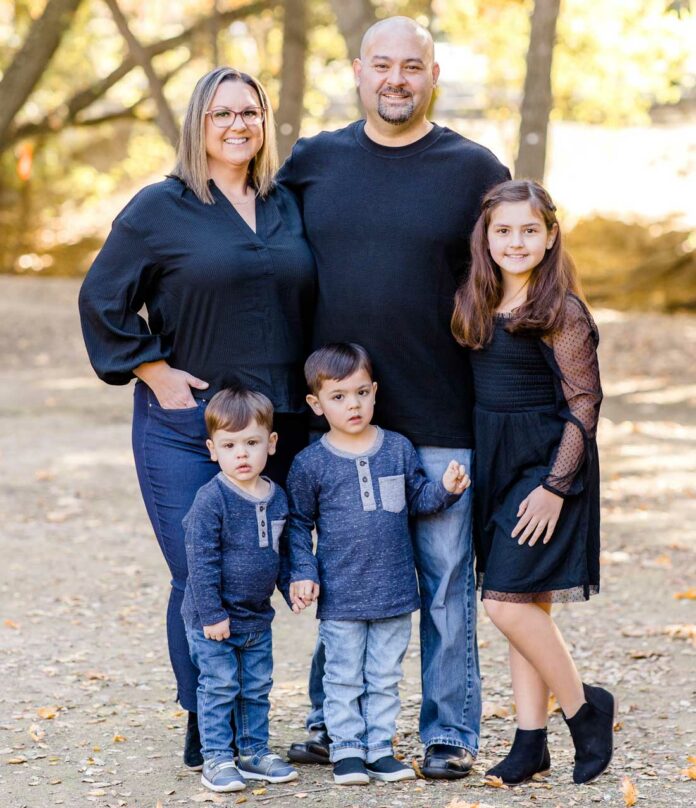
After Morgan Hill resident Kristina Andrews lost her daughter, Kourtney, to a drowning accident about six years ago, the local mother knew she wanted to do something to help prevent other families from suffering similar tragedies.
The desire to make a difference continued to grow after Andrews—who has been a nurse for about 13 years—had her son just over a year after Kourtney’s death. About that time, she found out about specialized survival swimming lessons for infants—known as Infant Swimming Resource or ISR lessons—and learned there was only one instructor in the entire Bay Area.
Andrews and a friend of hers decided it was time to expand the availability of ISR themselves, and in 2019 she started the local nonprofit Kourtney’s Kause. The organization offers ISR lessons for families throughout the South Valley, helps people become trained and certified in ISR instruction and provides community education about water safety.
Since March 2020, Kourtney’s Kause has provided ISR lessons to 342 children.
“It started out of a need of my own, but also being a parent that didn’t know a lot of things before Kourtney died, and saying we need to get this out there so parents even know this is available,” Andrews said in a recent interview.
With summer in full swing and a time when pool parties, beach gatherings and water-related activities are prevalent, Kourtney’s Kause has a series of ISR lesson openings coming up in Morgan Hill and Hollister (scholarships are available for those with a financial need). The lessons are geared toward infants and toddlers (ages 6 months to 6 years), teaching them how to use their sensory motor skills to survive a water accident by finding a float, catching their breath and seeking an edge or other stable surface to hold themselves up.
“As long as children can sit and roll over, we’ll teach them how to float,” said Andrews, herself a certified ISR instructor. “Then when they gain motor skills—(we teach them) to swim and float.”
Another vital tool in preventing accidental drownings is the awareness among parents that just a brief lapse in attention around water can be fatal to a child. Andrews’ daughter, Kourtney, was only 3 when she drowned at a pool party—where several adults and children of all ages were present—in south San Jose on July 15, 2017.
Studies have found that 88% of child drownings occur with at least one adult present, according to data presented by Kourtney’s Kause. One simple, yet important, pool party rule that adults could enforce on themselves is to have a “designated water watcher” who constantly has an eye on the swimming area—instead of assuming that all parents present are doing so.
“We want to draw special attention to events where there are a lot of people as this is a higher risk factor for drowning,” Andrews said. “It’s when everybody is watching and nobody is watching.”
Despite the relatively common occurrence of child drownings, Andrews said it’s a topic that many people avoid talking about, or think it won’t happen to their family. According to the National Drowning Prevention Alliance, drowning is the leading cause of death in children ages 1-4 and the second leading cause of death in children and teens ages 5-15.
In Santa Clara County, two children died of drowning in 2021; and one child drowned to death in 2022, according to the Medical Examiner-Coroner’s office.
In an incident last summer at the Morgan Hill Aquatics Center, Andrews witnessed another child drowning and sprung into action, likely saving the victim’s life. As her family was leaving the facility, they noticed some commotion coming from one of the pools.
A child, about age 5, was unresponsive and propped on a buoy surrounded by lifeguards and other bystanders. Andrews’ motherly and professional instincts—as well as the knowledge she has gained through building Kourtney’s Kause—kicked in as she ran over to help the child.
“I knew the victim needed air first” instead of chest compressions, Andrews said, and resuscitated the girl by giving her two “rescue breaths.” After that, the child’s pulse returned and she started coughing before emergency paramedics arrived at the scene.
Andrews—who has an 11-year-old daughter and two sons, ages 3 and 4—has stayed in contact with the girl’s family, and has since provided the daughter with a six-week session of survival swim lessons, she said.
Two key points in Andrews’ and Kourtney’s Kause’s message are a focus on “layered protection and a layered approach to water safety” which includes survival swim lessons; and the fact that CPR for a drowning victim differs from that for someone whose heart has stopped on land. Drowning victims suffer cardiac arrest through lack of oxygen to the brain, and chest compressions are not effective at providing needed oxygen without rescue breaths via mouth-to-mouth or an apparatus, Andrews explained.
Other layers of protection recommended by Andrews to prevent drownings include:
– Teach children to always ask permission before entering the water, and never enter alone.
– If you have a pool, ensure you have locks and alarms on all entrances to the pool area. Pools should be surrounded by a pool fence that is self-closing and self-latching, made of a mesh material that cannot be easily climbed.
– Prioritize survival swim lessons as early as possible for children as a safety measure. Lessons can begin as early as 6 months.
– Be sure to use properly fitting life jackets in or on open water.
– Parents and caregivers should consider becoming CPR certified.
Lessons available
Kourtney’s Kause offers private and group ISR swim lessons for ages 6 months to 6 years in South Valley and beyond. Sessions are scheduled at locations in Morgan Hill and Hollister through September. Scholarships are available for those with a financial need. For more information or to register a child for survival swim lessons, visit Kourtney’s Kause website at https://kourtneyskause.org/.













